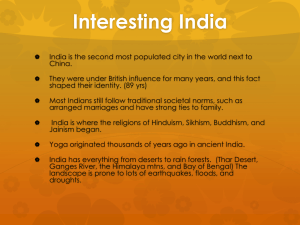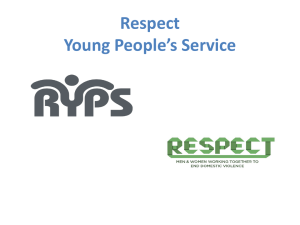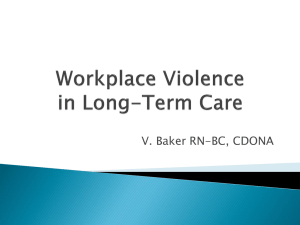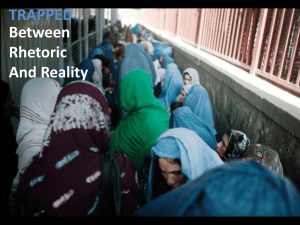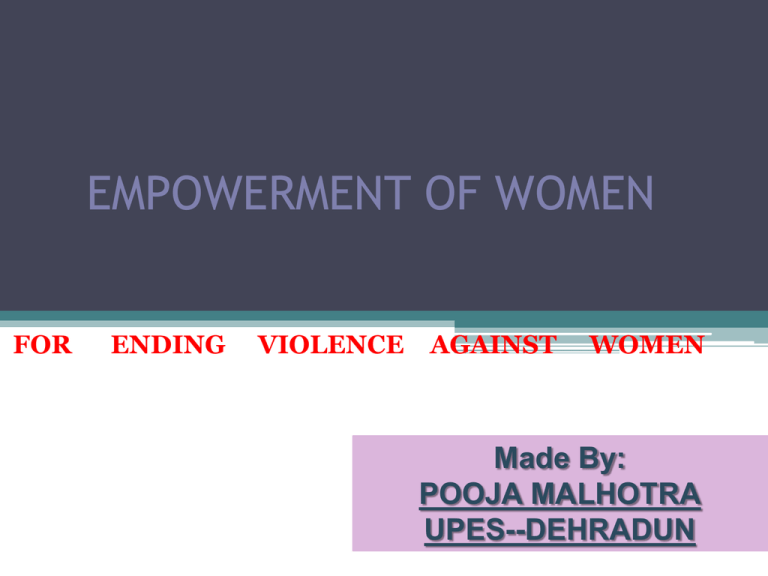
EMPOWERMENT OF WOMEN
FOR
ENDING
VIOLENCE
AGAINST
WOMEN
Made By:
POOJA MALHOTRA
UPES--DEHRADUN
DEFINITION
• BIASNESS AGAINST WOMEN -- DEFINED
• “Any act of gender-based violence that results in, or
is likely to result in, physical, sexual or
psychological harm or suffering to women and girls,
including threats of such acts, coercion or arbitrary
deprivations of liberty, whether occurring in public or
private life”.
Violence against women and girls
is on the increase.
More violent forms, such as
gang rapes, abductions, defilement and forced
early marriages,
Military sexual slavery, rape as a weapon of
war, trafficking in women and girls and
ill-treatment of widows have become more
widespread.
• There is a palpable feeling that legislation alone is not
enough to achieve equality in Africa, that it is not sufficient
to change perceptions, or cultures of sexism – the types of
cultures which are permissive to gendered violence
happening. Even with an increasing number of women in
parliament in some of the countries and increasing
legislation to prevent discrimination and violence on the
basis of gender, a culture of masculinity prevails. Why is
that?
Unequal power relationships continues
EMPOWERMENT OF WOMEN
TO END VAW- WHAT CAN WE DO?
• 1. Obtaining data on violence against women – use
these to show the economic and social cost of VAW as well
as emotional and psychological impact on the affected
person
• 2..It is important that the extent, nature and root causes of
such violence are well-documented. By analyzing such
information, concrete steps can be taken, both legal and
charitable, to reduce the occurrence of such violence and
reduce its effects.
• 3. Increase access to opportunities for women- empower
women to avoid abusive relationships - empower women,
free them to leave behind abusive relationships
• 4. Build capabilities of women- including physical
capabilities/ create awareness/ prevention programmes/
crisis counselling & support groups
• 5. Make ending VAW every one’s concern; everyone’s
business: The boys in your life need your time and energy.
Your son, grandson, nephew, younger brother, your male
colleague. The boys you teach, coach and mentor. All need
you to help them grow into healthy men.
The girls in your life what are you teaching them above all
what do they see!
• THE UN has identified violence against women and girls
"the most pervasive" human rights violation that we know
today. Statistics from the world over, paint a clear picture of
the social and health consequences of violence against
women.
• According to the United Nations Development Fund for
Women (UNIFEM), violence against women is a major
cause of death and disability for women aged 16 to 44
years
• The economic costs are considerable. Such violence
impoverishes not only individuals, but families,
communities, and governments, and stalls economic
development of each nation
How do you empower someone like
this?
• Paulo Freire speaks about conscientisation
process:
• Identify the individual
• Engage in dialogue/ Reflection
• Lead to Action
• Is your Neighbour, your sister, your friend being
abused? How do you engage to facilitate
empowerment?
Place of women in Indian society:
A (cultural) historical perspective
•
•
•
•
•
The Goddess (Devi)
The mother
The sister
The wife
The tawaif
Indian Women in Modern Times
Education
Literacy
› Gender gaps:
Differences across
states
(Kerala has highest
female literacy;
Rajasthan, Bihar and
Uttar Pradesh have
the lowest)
Differences between
rural and urban areas
Parental preference
for boys going to
school
Higher dropout rate
among girls
1971
1991
2003
Female
22%
39%
48%
Male
46%
64%
70%
Indian Women in Modern Times
Education
▫ Gender gaps in higher education
About 1 percent of total women population has
college education
Women account for a third of the students at
college/university level
In engineering and business, the proportion of
female students is much smaller
In education, nearly half of the students are women
Indian Women in Modern Times
Barriers to Female Education
▫ Poverty: one-fourth of India’s population lives
below the poverty line (2002)
▫ Social values and parental preferences
▫ Inadequate school facilities
▫ Shortage of female teachers: 29 percent at the
primary level and 22 percent at the university level
(1993)
▫ Gender bias in curriculum
Indian Women in Modern Times
Employment
▫ Difficult to get an overall picture of employment
among women in India
▫ Most women work in the informal sector
▫ Women accounted for only 23 percent of the total
workers in the formal sector in 1991
▫ The number of female workers has increased faster
than the number of male workers
▫ Female unemployment rates are similar to male
unemployment rates
Indian Women in Modern Times
Barriers to Female Employment
▫ Cultural Restrictions
Hierarchical society (caste system)
Purdah system: the veiling and seclusion of women
▫ Discrimination at Workplace
More prevalent in fields where male competition is high
Less prevalent in fields where competition is low
▫ Lack of employment opportunities
Indian Women in Modern Times
Empowerment
• Social Empowerment
▫ Education
There is no direct relationship between education
and work force participation; but may affect their
participation in household decision making
▫ Economic Independence:
Economic independence does not imply significant
improvement in social standing
Culture and tradition play an important role
A small fraction has opened up towards Western
values
“The origin of a child is a mother, a woman.
….she shows a man what sharing, caring, and
loving is all about. That is the essence of a
woman."
Sushmita Sen, Miss Universe 1994
Women and Legal Framework
Women specific Legislations
Immoral Traffic (Prevention) Act, 1956
The Maternity Benefit Act 1961
The Dowry Prohibition Act, 1961
Indecent
Representation
of
Women
(Prohibition) Act, 1986
The Commission of Sati (Prevention)Act,
1987
Protection of Women from Domestic
Violence Act, 2005
Evolution of Indian
Initiatives
Seventh
Plan
• 1985- Ministry of Human Resource
Development set up
Department
for
Women
and
Child
Development constituted in HRD Ministry
• 27 major women specific schemes
identified for monitoring to assess quantum
of funds/benefits flowing to women
Eighth Plan
• The Eighth Plan (1992-97) for the first time highlighted
the need to ensure a definite flow of funds from general
developmental sectors to women
• It commented:
“ … special programmes on women should complement
the general development programmes. The latter in turn
should reflect greater gender sensitivity”
Ninth Plan
Women’s Component Plan- 30% of funds
were sought to be ear-marked in all women
related sectors – inter-sectoral review and
multi-sector approach
Special vigil to be kept on the flow of the
earmarked funds/benefits
Quantifies performance under Women’s
Component Plan in Ninth Plan-Approach
Paper Tenth Plan indicates 42.9% of gross
budgetary support in 15 women related
Ministries/Departments has gone to women
Tenth Plan
Reinforces commitment to gender budgeting to establish its
gender-differential impact and to translate gender
commitments into budgetary commitments.
• Aims at initiating immediate action in tying up the two
effective concepts of Women Component Plan (WCP) and
Gender Budgeting to play a complementary role to each
other, and thus ensure both preventive and post-facto
action in enabling women to receive their rightful share
from all the women-related general development sectors.
Holistic approach to Empowerment
Health
& Nut.
Water & San.
Political
Participation
Education
Asset base
Skills
Marketing
Technology
Credit
Action Areas
• Women availing services of public utilities
like road transport, power, water and sanitation,
telecommunication etc.
• Training of women as highly skilled workerstop end skills
• Research/Technology for women
• Women in the work force
• Asset ownership by women
• Women as Entrepreneurs
• Implementation of Laws like
▫ Equal remuneration
▫ Minimum Wages
▫ Factories Act
• Infrastructure for women like
▫
▫
▫
▫
▫
Water and sanitation at workplace
Creches
Working Women Hostels
Transport services
Security
2005-06 National Family Health
Survey
(NFHS-3)
Gender Inequality and Women’s
Empowerment
Are some women more likely than others to
NOT participate in the use of their earnings?
Percent of currently married women
39
21
13
21
21
10
6
15-19
40-49
Age
Urban
Rural
Residence
None
12+
Education
8
Lowest
Highest
Wealth Index
Percentage of women age 15-49 who
are allowed to go alone to:
Market
51
Health facility
48
Places outside the
village/community
38
All three places
None of the three
places
33
4
The majority of women have little freedom of
movement. Only one-third go alone to all three
destinations: the market, health facility and
outside the village or community.
Percentage who agree that a husband is
justified in hitting or beating his wife if she:
37
41
Shows disrespect for in-laws
24
25
He suspects she is unfaithful
13
Doesn’t cook properly
Refuses to have sex
Argues with him
8
20
Women
14
26
29
Neglects the house or children
Goes out without telling him
At least one reason
30
23
35
29
51
54
Men
Key Findings
• Women are disadvantaged absolutely and
relative to men in terms of access to education,
media exposure, and employment for cash.
• The majority of married women do not have the
final say on the use of their own earnings or all
other household decisions asked about.
• Traditional gender norms, particularly those
concerning wife beating, remain strongly
entrenched.
• The answer to ending violence against
women is first and foremost based on
unequal power relations…The answer to
end violence lies with you as it is such a
complex issue
To Conclude
“It is more important to create a general
awareness’ and understanding of the
problems of women’s employment in all
the top policy and decision making and
executive personnel. There is also the
special problem facing women like the
preference for male children for social
and cultural reasons. This will require
awareness, understanding and action.
The best way to do so is to educate the
children, orient the teachers, examine
the text books and teaching-aids and
ensure that the next generation grows up
with new thinking.”
(6th Five Year Plan )
Thank You

